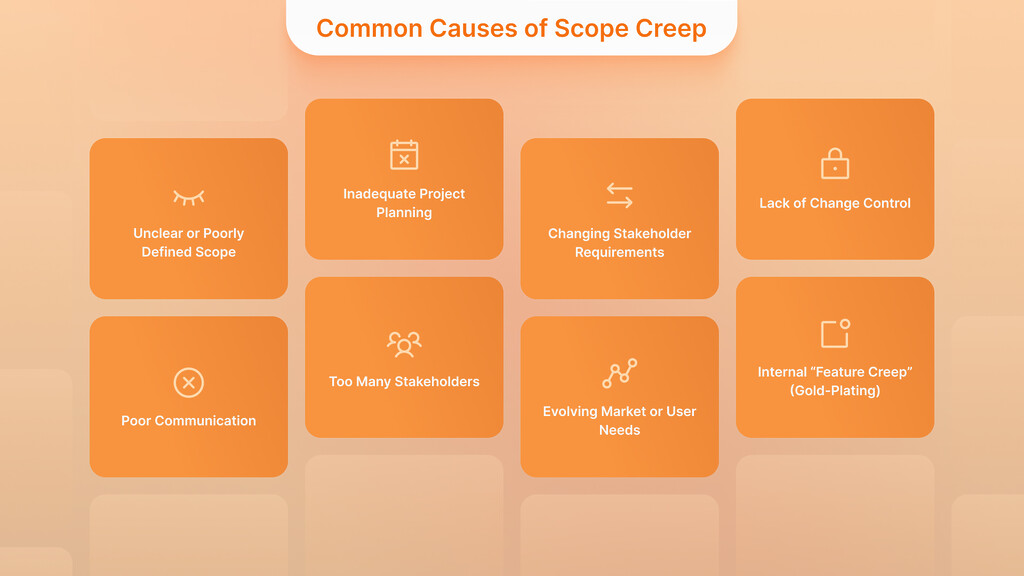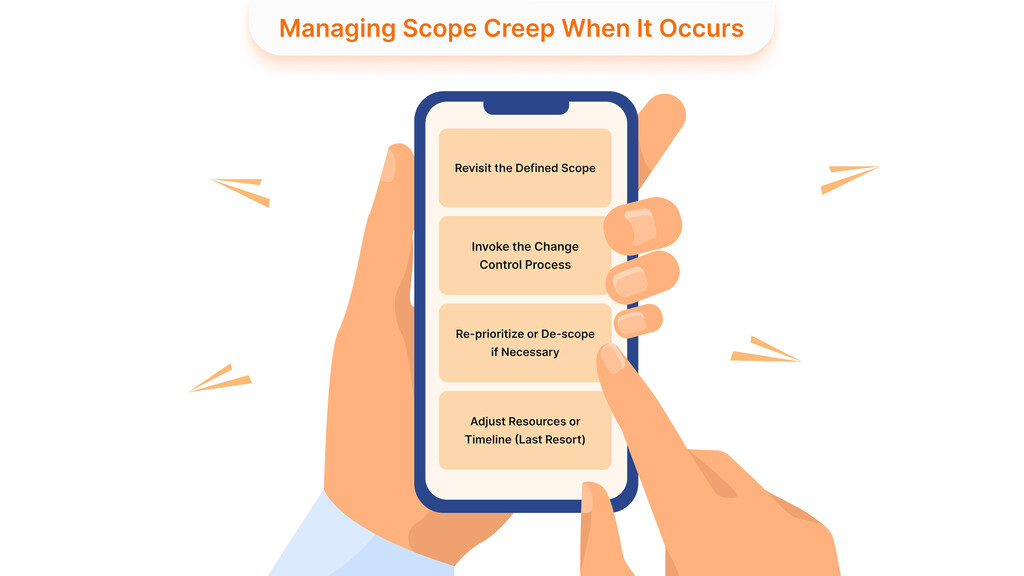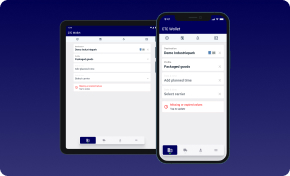Scope creep silently derails more software projects than any technical glitch. As new features slip in without formal review, budgets balloon, timelines slide, and the promised value of even the most sophisticated software evaporates. Whether you’re building a lightweight web app for a local shop or a nation-wide backend platform, unchecked requirement growth can turn disciplined plans into costly overruns. With the U.S. custom-software market expected to exceed $77 billion by 2030, mastering scope control is now a competitive necessity for every organization operating in the digital economy.
This guide unpacks why scope creep happens, how to prevent it with clear definitions and change-control processes, and what steps to take when it inevitably tries to sneak back in.
Experience the Power of Custom Software Development
Transformative Software Solutions for Your Business Needs
Explore Custom SoftwareWhat Is Scope Creep (and Why It’s a Problem)?
Any enlargement of the project scope that extends beyond the original project agreements will be classified as scope creep. Irregular project growth during software development commonly results from features or requirements added without proper reviews or controls, thus exceeding initial boundaries. The phenomenon where projects expand past their initial boundaries has two familiar names in the industry—”feature creep” and “requirement creep”. According to data from the Project Management Institute, this issue affects approximately 52% of projects.
The growth of the uncontrolled project scope creates significant difficulties because it affects timing schedules and spending levels and dissatisfies the team members. Introducing new deliverables and changes that skip plan adjustments causes delays and increased costs, affecting the project’s quality output. Project scope creep leads to workforce frustration that can disorientate team members and stakeholders enough to derail project success and turn it into failure. Software projects experience delivery setbacks if they exceed their original time and financial targets because of scope creep, unless appropriate management strategies are established.
Harmless initial additions to a project tend to expand through a domino effect. The unchecked propagation of minor additional features and scheduling demands produces significant delays and budget increases in most projects.
In the article “5 Most Common Software Development Costs Pitfalls,” inadequate requirement analysis is a leading cause of scope creep, often resulting in inflated project budgets. The author’s emphasis on detailed work breakdown structures supports proactive risk management.
Common Causes of Scope Creep

Detecting the scope creep causes is essential for avoiding this project evolution. The following factors lead to the occurrence of scope creep in software projects:
- Unclear or Poorly Defined Scope: The absence of clear documentation regarding project scope makes it simple for new features to enter the project unnoticed. When project deliverables remain unclear, people develop different understandings about project scope, inviting continuous add-ons.
- Inadequate Project Planning: Insufficient project planning, which includes collecting complete requirements and building complete plans, creates challenges for risk identification and dependency prediction. Unforeseen project complexities tend to surface mid-project, thus causing unanticipated changes.
- Changing Stakeholder Requirements: Projects experience frequent changes in their requirements because stakeholders tend to make modifications. First-level executives and clients seek updates by requesting additional features and changes. A lack of formal request-handling procedures damages projects by creating excessive workload.
- Lack of Change Control: The absence of defined change control procedures enables poor modification assessment, which provides unmonitored entry for new project ideas. When change control is missing from project systems, it leads to uncontrolled scope enlargement.
- Poor Communication: Misunderstandings appear when team members and stakeholders fail to share the same understanding. The absence of proper communication leads stakeholders to believe items that are not there are included, or causes task prioritization failures. These communication problems produce unexpected late developments that force the creation of more work.
- Too Many Stakeholders (Scope Creep by Committee): Project scope extension occurs when multiple stakeholders attempt active oversight, leading to networked modifications that expand the development work. A project without a designated authority as the decision-maker (project owner) allows competing direction changes to multiply throughout the scope.
- Evolving Market or User Needs: Market changes and shifting user requirements in the external environment lead to changes in project scope. The market’s performance and user opinions may necessitate project modifications that differ from the initial plans. Unforeseen technical issues and dependencies often compel the team to perform work beyond their initial plan.
- Internal “Feature Creep” (Gold-Plating): Team members themselves sometimes cause scope creep through “Feature Creep” by adding unrequested features or enhancements to improve the product. The practice of “gold-plating” causes unforeseen difficulties, which increase the amount of unfinished work and the prospect of delayed completion.
Project staff need to identify the root causes from the beginning of the project to maintain alertness. Many of these issues trace back to one theme: lack of clarity and control. The following section will explain methods for maintaining clear definitions and control, which suppress scope expansion.
In Mastering the Software Development Life Cycle (SDLC) Explained it is presented how poor change control can cause ripple effects throughout the lifecycle, often delaying delivery and bloating costs.
Best Practices to Prevent Scope Creep
Grasping scope creep requires appropriate prevention methods. The following actionable methods with best practices will maintain software project scope control right from the beginning:
Start with a Crystal-Clear Scope Definition
Project success demands that organizations define what belongs inside and outside the project boundaries during the initial phase. A formal Scope Statement and a charter require documentation of all requirements, project objectives, deliverables, limiting boundaries, and exclusion items. Creating a Work Breakdown Structure (WBS) enables teams to detail all necessary work activities. The document serves as a reference point that everyone follows and stops the development of features not included in the original scope definition.
IT Consultancy Designed Around Your Business Objectives
Expert Guidance to Optimize Your Technology Strategy
Discover IT ConsultingGet Stakeholder Alignment & Sign-off
All relevant stakeholders, including clients, product owners, and sponsors, need to review the scope document before getting their approval. Everyone must receive thorough clarification about the project deliverables and exclusions. At this time, it becomes essential to address and settle any misconceptions combined with differences of opinion regarding expectations. Implementing early stakeholder approval helps establish clear definitions, which become a foundation for rejecting unnecessary out-of-scope demands in the development period.
Define a Change Control Process
Understand that changes are natural because either requirements will change or new ideas will emerge. Implement a proper change control procedure at the outset to replace total change prohibition. The project maintains established rules requiring all change requests to undergo written evaluation analyses before approval from either the project manager or the change board. The established procedures protect the project from adopting changes without proper examination. The project will only accept valuable changes that require additional time and budget, since approved modifications need adequate documentation.
Communicate and Manage Expectations Continuously
Project managers must maintain continuous communication as a leading principle for the project duration. Maintain a routine of updated meetings with stakeholders, which feature progress reports and examinations of new demands. Stakeholders who receive ongoing updates learn about upcoming modifications before implementation, thus enabling them to make well-informed choices about modifications. You should clearly state the scope boundaries when needed to reinforce what was agreed upon (“As a reminder, feature X is beyond our current scope”). Informing everyone about possible changes at an early stage will avoid unexpected scope growth.
Document Every Request and Decision
Documentation discipline is in direct alignment with communication processes. Each new proposal or change requires documentation, which should exist within meeting records, email threads, or change logs. A written document that tracks all proposed change requests alongside the approvals and rejections becomes essential for scope control. The documented discussion lets you maintain evidence for any proposed “small thing” addition requests. Documentation systems with requirements documents and change logs establish a trusted reference point that stops misunderstandings about agreed specifications later in development.
Plan with Realism and Buffer
Realistic assumptions about project timelines and thorough resource planning should be established during the planning phases. All projects should incorporate additional time and funds to account for unforeseen events. Project scope changes will not cause issues when you decide beforehand to handle them without destroying project progress. The development of mitigation strategies must follow the identification of technical uncertainties, third-party dependencies, and other potential risks. Risk management executed proactively minimizes scope creep effects from unexpected issues because proper response plans were already created for those uncertainties.
Avoid Stakeholder Pleasing at the Expense of Scope
Maintaining happy clients and supervisors demands more than agreeing with every spontaneous demand they make. Implement polite yet firm boundaries regarding what changes can be incorporated into the project scope. When asked by stakeholders, show the requested addition to the agreed scope document or change management process. Teach your team and yourself to prevent automatic acceptance of additional work requests before conducting proper analysis. People often start by saying “it makes little difference” before several significant matters emerge. Maintain project organization through an official system for change evaluation instead of casual verbal agreements.
Empower Team Members to Guard the Scope
The project scope requires every development team member to grasp its definition and its restrictions. All members of the team should take part in scope management duties. Members of the design and development teams need encouragement to point out when work starts diverging from initial plans. The team members must fight against adding bonus features without proper change approval. The adequate change approval process requires team members to seek approval for all changes, regardless of helpfulness, according to a project management guide. The entire team can detect scope expansion early through proper disciplinary practices.
Use Tools to Track Scope
Use project management tools and templates to display the scope throughout its lifecycle. Organizations should use tools such as project plans and Kanban boards to display current tasks from the scope. All newly appearing tasks should get a proper change request assignment. Jira, Trello, and Asana provide centralized platforms that document requirements and track changes through real-time scope status reports (such as burndown charts or dashboards showing work progress). A quality control tool warns about new work additions so you detect scope creep at the moment it occurs.
Leading Development Teams for Your Success
Optimize Your Project Execution with Our Dedicated Development Teams
Get Your Development TeamSuch practices transform your project space into an organized environment where requirements become observable and planned transformations proceed based on established protocols. A well-designed scope foundation coupled with anticipatory management practices effectively stops scope creep at its inception. The MoSCoW Prioritization: Essential Guide for Project Management illustrates how categorizing requirements into Must, Should, Could, and Won’t Have can help focus efforts and resist feature creep. Also, the article on Master Prioritization for Project Management Tools underscores the value of incremental delivery and continuous iteration to maintain focus.
Managing Scope Creep When It Occurs

A project can experience scope creep even when team members try to prevent it. The project requirements shift during the process, and stakeholders demand additional features before completion. It is vital to handle scope creep immediately using deliberate methods when you identify its onset. The following steps should be followed to handle scope creep elements in progress:
Revisit the Defined Scope
Stop all ongoing discussions to direct attention toward the previously documented project scope. Summarize the initial project agreement with the group and stakeholders, including all original boundaries and exclusions. A review of the original scope documentation or contract helps stakeholders return to the established plan. The strategic reminder enables stakeholders to understand the original plan boundaries and their essential role in achieving project success.
Invoke the Change Control Process
Advise stakeholders to use the standard change control framework if they want to continue pursuing new requests. The stakeholders must file change request documents, which will undergo evaluation by you or a designated review group. The established process enables proper review of all requests that enter its framework. Analyzing how new requests affect timelines, resources, and costs will lead to a decision-making process that relies on facts rather than emotions. The evaluation process divides critical changes from optional changes because it reveals necessary trade-offs through analysis.
Re-prioritize or De-scope if Necessary
The project team needs to develop a plan to incorporate changes that pass the approval threshold as essential for project modification. The extra work should not be added to existing team responsibilities without a proper assessment. The project backlog features or deliverables must be assessed for any items that can shift to later phases or be deleted to accommodate the new addition. The project scope can remain manageable by introducing unapproved features through scope swaps, which remove other items either completely or postpone them to later phases. The project will adopt this new change by removing less important elements from the scope, instead of becoming cumbersome.
Adjust Resources or Timeline (Last Resort)
Next, you must re-baseline the project when neither scope item reduction nor time deferral options work for the necessary inclusion of the change. The two potential solutions for expanding the scope include delaying project completion dates and investing additional resources to handle new requirements. Acting solely for the sake of convenience constitutes an unsuitable approach, yet it becomes necessary under specific circumstances. Inform all stakeholders about modified project elements to explain how their specified change impacts the project. Showing all changes makes stakeholders question their habit of requesting unnecessary alterations.
Implementing this approach enables you to maintain control during times of scope creep threats to the project. Keeping scope changes out of informal processes remains the critical factor. The changes require direct attention through refusal, replacing other tasks, or modifying current plans. Decisive action and structured procedures enable you to refocus the project properly. All your documentation actions with approved changes must be recorded because updating the project scope statement or plan will keep your scope baseline always up-to-date.
Role-Based Insights: Project Managers, Developers, and Stakeholders
Every member involved in project development should participate in scope creep prevention and management processes. Different software development roles will find the following information applicable to their position:
For Project Managers
A project manager acts as the scope protector to set project boundaries while upholding their processes. A complete scope management plan must be developed at the beginning of the project by defining a scope statement with WBS, a schedule/budget baseline, and a change control procedure. The definition of responsibilities and decision-making power for scope change approvals must be clear to prevent confusion. The project manager should promote regular communication between teams and stakeholders by giving frequent updates to manage expectations and quickly resolve scope creep signs. As part of their duties, a project manager should teach stakeholders about the effects of change while stopping any unauthorized changes from occurring. Take steps in advance while keeping excellent detail focus, since preventing scope creep remains much simpler than trying to solve it afterwards.
For Developers & Team Members
Executors, including developers, testers, and designers, are the first operational line. The team needs authority to focus on approved requirements and adequately resist (professionally) any unexpected work. Keeping away from gold-plating is essential because you should only include new features or tweaks that have received explicit approval. Team members should refer stakeholders and managers to the project managers and establish change procedures whenever stakeholders directly request unplanned changes. Team members must understand that they need project approval before accepting unexpected scope modifications. Team members should state that they must show the request to the project lead to check compatibility. The agreed-upon process and documentation of the request safeguard the project. Project team members must notify the group about any requirements that seem to enter through back doors, such as minor bug fixes becoming new features, so the team can address these concerns openly. The development team writes code for the planned features while protecting the defined boundaries of these planned components.
For Clients/Stakeholders
A project vision derives from stakeholders, including clients, end-users, and internal executives. Stakeholders must establish detailed requirements when the project begins and share their complete needs during the earliest stages. Stakeholders must prioritize the scoping phase since changes made during project execution will probably require more time or financial resources. All stakeholders need to follow procedures for change control that have been previously approved. Direct your change proposals through formal communication channels before obtaining approval from the team about the impacts. Stakeholders need to understand that proper prioritization stands as a vital factor. Stakeholders who establish their priorities help the team make wise decisions about postponing launch dates for certain non-essential features (they decide which additional features require delaying launch time and which do not). Stay actively involved with project team communication by attending status reports and expressing your concerns immediately. Realistic collaboration between stakeholders and project teams decreases the risk of project deviations. The extra feature you desire can be added to the project, but will require adjusting the timeline or budget parameters. Project success becomes healthier when all participants demonstrate mutual understanding of this reality.
Overall, cooperation and strict adherence to guidelines describe how each role understands scope creep. Project managers, team members, and stakeholders require a shared understanding of the scope to implement set rules to control changes. All members who participate in scope management effectively maintain control over scope creep. How User Experience (UX) Drives Revenue and Reduces Costs emphasizes the importance of upfront UX documentation to prevent mid-project overhauls.
Practical Tips for Better Scope Control

This conclusion provides daily software project scope control strategies for any team member to apply.
Communicate Early and Often
Regular discussions should replace the assumption that team members understand things equally as time progresses. Scoping issues and expectation changes become scope modifications only when project members communicate frequently. Ask for questions and verify scope requirements throughout the entire project duration.
Write Things Down
All unrecorded items remain nonexistent. Documentation proves everything’s existence. Create a practice of recording every requirement with all decisions and change requests. All projects benefit from meeting notes, requirement specs, and change logs. Every written agreement and change eliminates misunderstandings about what was truly agreed upon.
Stick to the Change Process
The change control process should be an absolute priority for your organization. A formal change procedure exists for every situation, even if a proposed change appears insignificant. Formal discussions about changes should also take place for every minor adjustment. The formalized process shields you from accumulating excessive unwanted “just one more thing” enhancements. Approve all proposed changes only after doing a thorough assessment of their implications.
Use “Out of Scope” Lists
The use of explicit “Out of Scope” Lists is a valuable strategy because these documents specify all features or ideas that will not be included. The documentation includes this list as part of the project records. Check the out-of-scope list before considering new proposals. The item already exists as an official record, which properly explains current non-performance or serves as grounds for independent estimation as a standalone work.
Educate and Remind Stakeholders
Educating stakeholders about project restrictions should be a standard procedure in every project. The client’s decision to refuse the addition becomes viable when they receive your information about a deadline extension or a cost increase. Changes are acceptable only for essential needs, yet they require extra time or budget expenditure (you cannot perform miracles). Thoughtful change requests emerge through this practice, which replaces impulsive requests.
Conduct Scope Reviews
At each major milestone or sprint review stage, a quick scope review should be performed. The current work status should be compared with the original scope document. Does the work match what was originally promised to the customer? This method enables projects to detect scope creep during their initial stages. A single sprint of drift is easier to fix than letting it persist for six months.
Learn from Past Projects
A retrospective meeting should occur after project completion to review scope creep activities specifically. What caused it? What steps could be taken to prevent or enhance the management of this situation? The acquired knowledge should guide scope definition and control practices for future projects. Your scope management skills will improve continuously through ongoing improvement practices.
The advice teaches a fundamental lesson about maintaining clarity and control. Detailed documentation, clear communication methods, and constant control enforcement allow you to better control your scope. Additionally, The Importance of Product Discovery in Building Successful Software Products article explains how early discovery can prevent unrealistic demands and align teams around achievable goals.
Streamlining Your Path to Effective Product Discovery
Make Your Ideas a Reality in Four Weeks with Our Results-Driven TechBoost Program
See Product Discovery ServicesStay On Track: Build What Matters Most
The project-killing label known as scope creep does not necessarily need to become reality. Through proper planning and boundary definition alongside active scope management, software development teams can achieve their promises without unexpected occurrences. It remains simpler to avoid scope creep through early planning instead of attempting to resolve it afterward. Thus, business leaders should focus on defining and communicating project scope from the beginning. Approach changes that occur inevitably with open awareness while having a prepared strategy.
A project that receives proper management allows scope modifications to occur as intentional alterations instead of spontaneous, unanticipated changes. Properly established scope baselines and effective change controls, coupled with constant communication, allow you to control software development projects effectively while preventing excessive scope expansion. Project management approaches deliver outcomes that achieve objectives and please stakeholders through stable project targets. The strategies taught in this guide give you the power to control and lead projects to achievement despite potential scope creep challenges.










